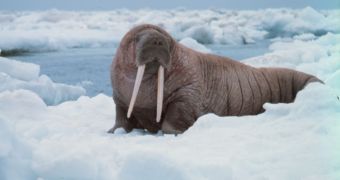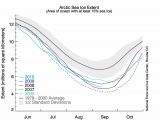According to the latest data supplied by the National Snow and Ice Data Center (NSIDC), it would appear that 2010 saw the third lowest extent of sea ice in the North Pole ever recorded.
The discovery was also accompanied by another one, which showed that large numbers of walruses had come aground in Alaska, due to the fact that the ices they normally inhabited melted.
One thing that should really worry everyone is that the top three lowest sea ice extents in the Arctic have been recorded since 2007. In other words, equally-low coverage levels were never seen before.
A team of experts working for the US Geologic Survey (USGS) recently found an estimated 10,000 to 20,000 walruses congregated onshore in Alaska, a sign that their natural habitats are shrinking.
Walruses can be seen as an indicator to ice health, experts say, given the intimate nature of the ecosystemic relations connecting the two.
According to a new USGS report called “Projected Status of the Pacific Walrus in the 21st Century,” it would appear that, if the current melting trend continues, this would lead to a “clear trend of worsening conditions for the Pacific walrus.”
Walruses, bearded seals and ring seals are currently being considered as possible “additions” to the Endangered Species Act, after the polar bear was added in 2008 by the Bush Administration.
At this point, groups such as the World Wide Fund for Nature (WWF) are engaged in actions meant to curb the dangers walruses are subjected to, and to urge authorities to take the proper measures to mitigate the situation.
In 2009, the organization began working with US Fish and Wildlife Service (FWS) and Alaskan indigenous communities for protecting these animals, as well as polar bear.
The grassroots efforts are ongoing on the coast of the Chukchi Sea. Additionally, the WWF has also been involved in a similar initiative in eastern Russia.
“The crowded conditions we are witnessing are particularly dangerous because walruses are easily startled and can stampede, resulting in the trampling deaths of dozens, sometime hundreds of walruses,” says the Senior Conservation Officer of the WWF Global Arctic Program, Geoff York.
“This troubling situation will continue to play out over and over, becoming increasingly severe as climate change escalates the melting of the walruses’ sea ice habitat,” York continue.
“The survival of pacific walruses in anything resembling their numbers today is at serious risk without immediate action to reduce greenhouse gas pollution. If we don’t take action now we will be condemning walruses and other ice-dependent species to a very uncertain future,” he goes on to say.
According to the official press release by NSIDC, it would appear that Arctic sea ice reached its annual minimum extent on September 10.
From 2007 onwards, only 2009 showed a slight increase in total ice coverage. Otherwise, 2007, 2008 and 2010 all showed record-low ice extents.
“In the beginning of October, NSIDC will issue a formal announcement with a full analysis of the melt season, and graphics comparing this year to the long-term record,” say NSIDC officials in the document.
“We will also announce the monthly average September sea ice extent, the measure scientists rely on for accurate analysis and comparison over the long term,” they go on to say.
“We will continue to post analyses of sea ice conditions throughout the year, with frequency determined by sea ice conditions. The near-real-time daily image update will continue each day,” the team adds.
Officials at the WWF say that the new data is very worrying, and add that authorities would do well to give it the proper consideration.
Oddly enough, some government agencies and certain individuals for some reason disagree with the scientific consensus on global warming and climate change, and as such don't see ice melt as an issue.
However, the tens of thousands of stranded walruses, and the large number of missing polar bears would beg to differ. And these are the effects the phenomena have in the North Pole alone.
“The extreme continued thinning of Arctic sea ice underscores that we cannot afford to lose any time in coping with climate change and its consequences,” says Martin Sommerkom.
“Ice-dependent species such as walrus are the first to be affected by thinning sea ice. But we already see that the loss of sea ice is also affecting the soils and vegetation of the surrounding arctic lands,” he adds.
“Projections are forecasting a near complete loss of the summer ice cover within one generation. We have to intensify our preparedness to deal with these changes if we want to maintain ecosystems people in the Arctic and the world depend upon,” says the scientist.
“Thinning arctic sea ice highlights to the world that climate change is real, it is ongoing and the consequences are accelerating, regardless of our current inability to agree on actions to tackle the roots of the problem,” concludes Sommerkorn, who is a Senior Climate Change Officer at the WWF Global Arctic Program.

 14 DAY TRIAL //
14 DAY TRIAL // 
